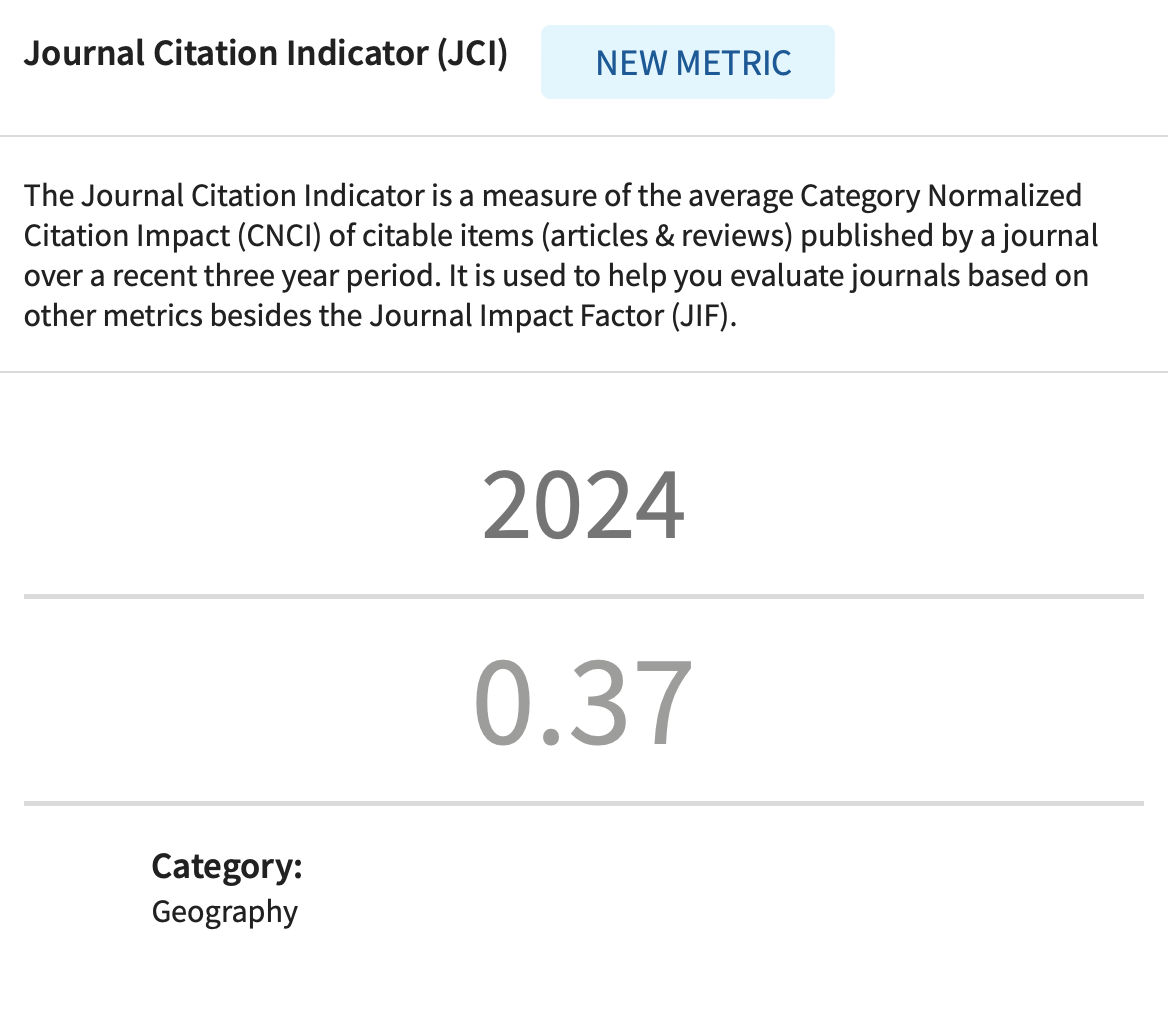ANTHROPOGENIC IMPACT ON SOIL AND VEGETATION IN TURKISTAN REGION: CHEMICAL COMPOSITION AND HEAVY METAL CONTAMINATION
DOI:
https://doi.org/10.2298/IJGI240426013AKeywords:
chemical composition, environmental impact, anthropogenic activities, land resourcesAbstract
The main purpose of this study is to analyze the anthropogenic impact on the soil and vegetation cover of the landscapes of the Turkistan region (southern part of Kazakhstan), and to investigate the chemical composition of elements and pollutants. The current state of landscapes with patterns of distribution of chemical elements and the influence of anthropogenic activity have been revealed. Quantitative indicators of the content of chemical elements (carbon, oxygen, sodium, magnesium, aluminum, silicon, potassium, calcium, titanium, iron, lead, arsenic, copper, zinc, nickel, cobalt, vanadium, thallium, manganese, and strontium) were studied based on soil samples. The levels of concentration of chemical elements of vegetation cover, aboveground and underground parts (carbon, oxygen, sodium, magnesium, aluminum, silicon, phosphorus, sulphur, chlorine, potassium, calcium, iron and copper) were assessed. The results of the chemical analysis of the soil cover revealed an excess of the maximum permissible concentration of chemical elements (lead, copper, zinc, arsenic, and chromium), while elevated levels of insoluble ash were observed in plants.
Article metrics
References
Abera, T., Heiskanen, J., Maeda, E., Odongo, V., & Pellikka, P. (2023). Impacts of land cover and management change on top-of-canopy and below-canopy temperatures in Southeastern Kenya. Science of The Total Environment, 874, Article 162560. https://doi.org/10.1016/j.scitotenv.2023.162560
Ahmad, W. S., Kaloop, M. R., Jamal, S., Taqi, M., Hu, J. W., & El-Hamid, A. H. (2024). An analysis of LULC changes for understanding the impact of anthropogenic activities on food security: A case study of Dudhganga watershed, India. Environmental Monitoring and Assessment, 196, Article 105. https://doi.org/10.1007/s10661-023-12264-9
Alikulov, S. M., Baymetov, K. I., & Abdullaev, F. Kh. (2023). Ekspeditsionnyye obsledovaniya po sboru rastitelnykh resursov Respublik Tsentralnoy Azii [Expeditionary surveys on collection of plant resources of Central Asian Republics]. Central Asian Journal of Medical and Natural Science, 4(4), 68–81. https://cajmns.centralasianstudies.org/index.php/CAJMNS/article/view/1665
Aslam, R. W., Shu, H., Javid, K., Pervaiz, S., Mustafa, F., Raza, D., Bilal Ahmed, B., Quddoos, A., Al-Ahmadi, S., & Hatamleh, W. A. (2024). Wetland identification through remote sensing: Insights into wetness, greenness, turbidity, temperature, and changing landscapes. Big Data Research, 35, Article 100416. https://doi.org/10.1016/j.bdr.2023.100416
Assede, E. S., Orou, H., Biaou, S. S. H., Geldenhuys, C. J., Ahononga, F. C., & Chirwa, P. W. (2023). Understanding drivers of land use and land cover change in Africa: A review. Current Landscape Ecology Reports, 8, 62–72. https://doi.org/10.1007/s40823-023-00087-w
Dağyeli, J. (2023). Lasting legacies in Central Asia’s agro-pastoralist livelihoods. In F. de la Croix & M. Reeves (Eds.), The Central Asian World (pp. 39-52). New-York: Routledge. http://surl.li/pukdy
Du, L., Dong, C., Kang, X., Qian, X., & Gu, L. (2023). Spatiotemporal evolution of land cover changes and landscape ecological risk assessment in the Yellow River Basin, 2015-2020. Journal of Environmental Management, 332, Article 117149. https://doi.org/10.1016/j.jenvman.2022.117149
Duan, X., Chen, Y., Wang, L., Zheng, G., & Liang, T. (2023). The impact of land use and land cover changes on the landscape pattern and ecosystem service value in Sanjiangyuan region of the Qinghai-Tibet Plateau. Journal of Environmental Management, 325(Part B), Article 116539. https://doi.org/10.1016/j.jenvman.2022.116539
Fedoniuk, T. P., Pyvovar, P. V., Skydan, O. V., Melnychuk, T. V., & Topolnytskyi, P. P. (2024). Spatial structure of natural landscapes within the Chornobyl Exclusion Zone. Journal of Water and Land Development, 60, 79–90. https://doi.org/10.24425/jwld.2024.149110
Franco-Rozo, M. C., Blanco-Torres, A., Gomez-Valencia, B., & Etter, A. (2024). Biodiversity responses to landscape transformations caused by open-pit coal mining: An assessment on bats and dung beetles in a Colombian tropical dry forest. Environmental and Sustainability Indicators, 21, Article 100335. https://doi.org/10.1016/j.indic.2024.100335
Glibovytska, N., & Shkitsa, L. (2020). Assessment methodology of green plantations vitality in the conditions of technogenically transformed ecosystems. Ecological Safety and Balanced Use of Resources, 11(2), 19–24. https://doi.org/10.31471/2415-3184-2020-2(22)
Gorshkov, S. P. (1982). Ekzodinamicheskiye protsessy osvoyennykh territoriy [Exodynamic processes of developed areas]. Nedra Publishers. https://www.geokniga.org/bookfiles/geokniga-ekzodinamicheskie-processy-osvoennyh-territoriy.pdf
Guo, Y., Ren, Z., Wang, C., Zhang, P., Ma, Z., Hong, S., Hong, W., & He, X. (2024). Spatiotemporal patterns of urban forest carbon sequestration capacity: Implications for urban CO2 emission mitigation during China’s rapid urbanization. Science of the Total Environment, 912, Article 168781. https://doi.org/10.1016/j.scitotenv.2023.168781
Huang, Z., & Yu, F. (2023). InSAR-derived surface deformation of Chaoshan Plain, China: Exploring the role of human activities in the evolution of coastal landscapes. Geomorphology, 426, Article 108606. https://doi.org/10.1016/j.geomorph.2023.108606
Illienko, V. V., Volkogon, I. V., Bordyug, O. A., Klepko, A. V., Lazarev, M. M., & Gudkov, I. M. (2023). Tselyulozoruynuyucha aktyvnist gruntovoyi mikroflory za vplyvu riznykh rivniv radionuklidnoho zabrudnennya [Cellulose destructive activity of soil microflora at the influence of different radionuclide contamination levels]. Scientific Reports of the National University of Life and Environmental Sciences of Ukraine, 3(103). http://dx.doi.org/10.31548/dopovidi3(103).2023.004
Khodjimatov, A. N., & Baimurotov, S. M. (2023). Prognozno-informativnyye cherty abioticheskikh komponentov aridnykh zon Uzbekistana [Prediction and informational features of abiotic components in arid zones of Uzbekistan]. Applied Sciences in the Modern World: Theory and Practice, 1(1), 108-113. https://wordlyknowledge.uz/index.php/PPSM/article/view/1175
Kolluru, V., John, R., Saraf, S., Chen, J., Hankerson, B., Robinson, S., Kussainova, M., & Jain, K. (2023). Gridded livestock density database and spatial trends for Kazakhstan. Scientific Data, 10, Article 839. https://doi.org/10.1038/s41597-023-02736-5
Komilova, N. K., Ermatova, N. N., Rakhimova, T., Karshibaeva, L. K., Hamroyev, M. O. (2021). Urboekological situation and regional analysis of population health in Uzbekistan. International Journal of Agricultural Extension, 9, 65–69. https://doi.org//10.33687/ijae.009.00.3722
Kumar, S., Singh, V., & Saroha, J. (2023). Interpretation of land use/land cover dynamics with the application of geospatial techniques in Sarbari Khad watershed of Himachal Pradesh, India. GeoJournal, Article 88, 2623-2633. https://doi.org/10.1007/s10708-022-10769-3
Li, C., Fang, S., Geng, X., Yuan, Y., Zheng, X., Zhang, D., Li, R., Sun, W., & Wang, X. (2023). Coastal ecosystem service in response to past and future land use and land cover change dynamics in the Yangtze River estuary. Journal of Cleaner Production, 385, Article 135601. https://doi.org/10.1016/j.jclepro.2022.135601
Lyubchik, S. B., Lyubchik, A. I., Lygina, E. S., Lyubchik, S. I., Makarova, T. L., Vital, J., Rego, A. M. B., & Fonseca, I. M. (2008). Simultaneous removal of 3d transition metals from multi-component solutions by activated carbons from co-mingled wastes. Separation and Purification Technology, 60(3), 264– 271. https://doi.org/10.1016/j.seppur.2007.08.020
Mukayev, Z. T., Ozgeldinova, Z. O., Sibirkina, A. R., Asylbekov, K. M., Alagudzhaeva, M. A., & Ospan, G. T. (2019). Content of manganese in soils of the Alakol hollow. News of the Academy of Sciences of the Republic of Kazakhstan, 2(434), 114–119. http://www.geolog-technical.kz/images/pdf/g20192/114-119.pdf
On Approval of Hygienic Standards for the Safety of the Living Environment, No. 452. Ministry of National Economy of the Republic of Kazakhstan. (2015), June 25 https://adilet.zan.kz/rus/docs/V1500011844
Ozgeldinova, Z. O, Janaleyeva, K. M., Auyezova, Z. T., Mukayev, Z. T., & Ramazanova, N. (2015). The present-day geoecologic situation of Kenghir River basin geosystem. Biosciences Biotechnology Research Asia, 12(3), 3041–3051. https://pdfs.semanticscholar.org/ec60/b3147612e6fc30975687e75e16588ea8591c.pdf
Ozgeldinova, Z. O., Janaleyeva, K. M., Auyezova, Z. T., Mukayev, Z. T., Saipov, A. A., Ospan, G. T., & Kaygusuz, M. (2019). Assessment of human impacts on geosystems of Sarysu River Basin. Fresenius Environmental Bulletin, 28(8), 6019–6026. https://gcris.pau.edu.tr/handle/11499/30488
Panfilova, A., Korkhova, M., Gamayunova, V., Fedorchuk, M., Drobitko, A., Nikonchuk, N., & Kovalenko, O. (2019). Formation of photosynthetic and grain yield of spring barley (Hordeum vulgare L.) depend on varietal characteristics and plant growth regulators. Agronomy Research, 17(2), 608–620. https://doi.org/10.15159/AR.19.099
Raj, P., Padiyath, N., Semioshkina, N., Foulon, F., Alkaabi, A. K., Voigt, G., & Addad, Y. (2022). Transfer of natural radionuclides from soil to Abu Dhabi date palms. Sustainability, 14(18), Article 11327. https://doi.org/10.3390/su141811327
Semak, U., & Mylenka, M. (2024). Mulching as a restoration method of revegetation at ash and slag dumps of Burshtyn TPP. Scientific Horizons, 27(3), 73-83. https://doi.org/10.48077/scihor3.2024.73
Shaforost, Y., Pogrebniak, O., Lut, O., Litvin, V., & Shevchenko, O. (2024). Chemical military-technogenic load on the soils of military training grounds. Plant and Soil Science, 15(2), 67–79. https://doi.org/10.31548/plant2.2024.67
Shamshiev, B. N., Ibraev, E. B., Zhumabaev, M. S., & Borombayev, A. (2022). Resheniya ekologicheskikh problem v zakaznikakh yuga Kyrgyzskoy Respubliki [Solutions to environmental problems in nature reserves of the south of the Kyrgyz Republic]. News of Osh Technological University, 2, 148–162. http://surl.li/puhvk
Sofi, I. I., Shah, M. A., & Ganie, A. H. (2023). Integrating human footprint with ensemble modelling identifies priority habitats for conservation: A case study in the distributional range of Arnebia euchroma, a vulnerable species. Environmental Monitoring and Assessment, 195, Article 914. https://doi.org/10.1007/s10661-023-11528-8
Tikhonova, L. P., Goba, V. E., Kovtun, M. F., Tarasenko, Y. A., Khavryuchenko, V. D., Lyubchik, S. B., & Boiko, A. N. (2008). Sorption of metal ions from multicomponent aqueous solutions by activated carbons produced from waste. Russian Journal of Applied Chemistry, 81(8), 1348–1355. https://doi.org/10.1134/S1070427208080065
U.S. Environmental Protection Agency. (2005). Ecological soil screening levels for arsenic. https://www.epa.gov/sites/default/files/2015-09/documents/eco-ssl_arsenic.pdf
U.S. Geological Survey (USGS). (2023). Landsat 9 imagery, Scene ID for the Turkistan region, Kazakhstan. Available at: https://earthexplorer.usgs.gov/
Valeyev, A. G., Zinabdin, N. B., Sharapkhanova, Zh. M., & Abitbayeva, A. D. (2023). Sovremennoye relyefoobrazovaniye severnogo priaralya v usloviyakh regressii morya [Modern relief formation of the Northern Aral region under the conditions of the sea regression]. Bulletin of Al-Farabi Kazakh National University, 68(1), 4–20. https://bulletin-geography.kaznu.kz/index.php/1-geo/article/view/1263
Vinogradov, A. P. (2020). Khimicheskiy elementarnyy sostav organizmov morya [The chemical elementary composition of marine organisms]. Russian Academy of Sciences. https://www.geokniga.org/bookfiles/geokniga-tom1himicheskiyelementarnyysostavorganizmovmorya.pdf
Wang, Q., Xiong, K., Zhou, J., Xiao, H., & Song, S. (2023). Impact of land use and land cover change on the landscape pattern and service value of the village ecosystem in the karst desertification control. Frontiers in Environmental Science, 11, Article 1020331. https://doi.org/10.3389/fenvs.2023.1020331
Wolf, I. D., Sobhani, P., & Esmaeilzadeh, H. (2023). Assessing changes in land use/land cover and ecological risk to conserve protected areas in urban-rural contexts. Land, 12(1), Article 231. https://doi.org/10.3390/land12010231
Zhang, X., Gao, S., Wu, Q., Li, F., Wu, P., Wang, Z., Wu, J., & Zeng, J. (2023). Buffer zone-based trace elements indicating the impact of human activities on karst urban groundwater. Environmental Research, 220, Article 115235. https://doi.org/10.1016/j.envres.2023.115235
Zhou, Y., Batelaan, O., Guan, H., Liu, T., Duan, L., Wang, Y., & Li, X. (2024). Assessing long-term trends in vegetation cover change in the Xilin River Basin: Potential for monitoring grassland degradation and restoration. Journal of Environmental Management, 349, Article 119579. https://doi.org/10.1016/j.jenvman.2023.119579
Zhumanov, M. A. (2022, June 28-30). K ekologii orla-mogilnika Aquila heliaca v Karakalpakstane [On ecology of the eagle Aquila heliaca in Karakalpakstan]. International Scientific and Practical Conference “Ecological monitoring of the Aral Sea catastrophe consequences for human health and conservation of the biosphere”. Nukus, Uzbekistan. http://surl.li/puhvd
Downloads
Published
How to Cite
Issue
Section
License
Copyright (c) 2025 Journal of the Geographical Institute “Jovan Cvijić” SASA

This work is licensed under a Creative Commons Attribution 4.0 International License.











